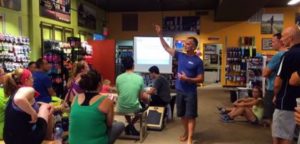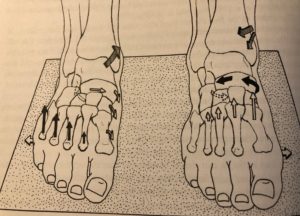restore: the legs program
the feet
Let’s talk about our feet:
“Athletes quickly do better on things like video games, but not because their reaction time and reflexes are better. It’s because they recognize patterns faster. We look at movement as output, but movement is about input, which is why proprioception and mobility are so important.”
– Gray Cook
Barefoot Training: Running and Beyond:
Thinking back, it seems like so long ago now that the book “Born To Run,” came out. What followed the subsequent climb to the top of the best-seller list was, as you remember I’m sure, debates on forums and message boards, untold articles and opinions espousing the benefits (OR dangers) of barefooted running, complete changes in running shoe design, and marketing, and one company (Vibram 5-Fingers) even ended up in a 3.75 million dollar class-action lawsuit
So yes, a LOT has been written and said about barefoot running since that book. In a weird sort of way, it almost seems like old news now – like there’s not a lot new to discuss, you know?
From my perspective, while the dust has settled on the barefoot running craze and controversy, the potential benefit to barefoot TRAINING is more real than ever.
Unfortunately, many still don’t distinguish between barefoot training and barefoot running.

There I am sharing what I learned with a group of runners at Fleet Feet!
When I presented my first “Barefoot Training: Running and Beyond” talk back in 2016 at Fleet Feet in West Hartford, Connecticut, I was a bit taken aback when both of the folks who spoke to the group before me (and subsequently introduced me) specifically referred to my talk as being about barefooted running.
It wasn’t.
I was thinking to myself as I listened, “don’t they know why I am here and what I’m going to talk about?”
It’s time to shift our thinking!
I don’t fault them for partially introducing my talk incorrectly. I straightened it all out with a smile once I began chatting with the group.
I’m telling you straight up, you need to stop and consider just how important your feet are to your overall health and athletic performance, especially your running. If you don’t, you may be sorry somewhere down the road.
In the words of one of my mentors, podiatrist Dr. Emily Splichal, “It is time to expand our minds – set aside preconceptions and images of people running on concrete without shoes – and take a moment to understand and EXPERIENCE the power of training barefoot.”
- As your toe and foot function deteriorate with miles or age (or both), at best you risk losing your ability to run at all. At worst you’re looking at an altered gait and chronic pain for the rest of your life.
- The science behind purposeful foot activation and barefoot training is growing every day. I’ve learned so much since that talk in 2016 in my work as a Fascial Stretch Therapist and Barefoot Training Specialist, it’s been mind-boggling to me!
- There’s a powerful interconnection between the deep foot stabilizers (intrinsic muscles) and your hip and core stability, which translates directly to your performance. If your feet don’t talk to your brain and your trunk (proprioception from the ground up), no amount of planking or any other “core” exercise will make you bulletproof or strong and stable.
- Your foot IS your connection to the ground. If it isn’t stable and functioning well, you won’t be able to absorb or handle impact forces nearly as efficiently. You’ll “leak” energy with every footstrike and dare I say it, your risk of injury goes up too.
- This isn’t just about simply removing your shoes to train. While there are benefits to going unshod more often, please remember that your feet do NOT automatically act the way they were “designed” to just because you don’t have your shoes on. That might be true for someone who has NEVER (or hardly ever) worn shoes (like the Tarahumara), but I doubt that describes you, does it?
To PRINT a PDF of the information on this page for off-line reading, CLICK HERE!
With improved foot function via barefoot training, can we…

The ways in which the foot can move. Source: Bosch and Klomp – Running: Biomechanics and Exercise Physiology Applied in Practice
1. Improve foot health and whole-body function/muscle activation…
2. Tune in and enhance proprioception for better foot (and whole-body) function, and…
3. Improve core and hip stability and…
4. Do it conveniently and progressively to ultimately improve our running speed and durability?
The answer to all of these questions is a resounding YES!
What do you say? Let’s get to work!
In this 55-second video below that was created for Instagram, I demonstrate some of the things I’m doing routinely to care for my 60+ year old “dogs” that have supported me through more than 40 years as a competitive runner and triathlete. This is a sample of some of the things I do – as I call it, “the price I pay to play!” 🙂
